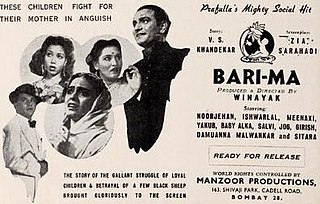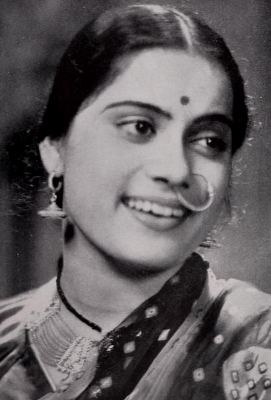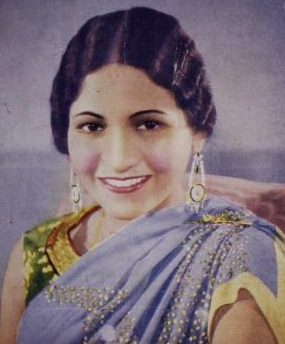
Marathi Cinema, also known as Marathi Chitrapat, is the segment of Indian cinema, dedicated to the production of motion pictures in the Marathi Language widely spoken in the state of Maharashtra. It is based in Mumbai. It is the oldest film industry of India and one of the leader in Filmmaking in India's film industry. The first Marathi talkie film was Ayodhyecha Raja, released in 1932, just one year after Alam Ara the first Hindi talkie, before releasing the Aayodhyecha Raja, all the Marathi films until then were Silent films with Intertitles.

Prabhat Film Company was an Indian film production company and film studios founded in 1929 by the noted film director V.Shantaram and his friends.
Maya Macchindra, also titled alternatively as Alakh Niranjan, is the title of various films produced in different languages in India. The story is based on the life of Matsyendranath or Machindranath one of the eighty-four Mahasiddhas, tantric yogic master and the founder of nath lineage, and his famous disciple, baba Gorakhnath.
Vinayak Damodar Karnataki commonly referred to as Master Vinayak was an Indian actor and film director of the 1930s and 1940s.

Bhalji Pendharkar was a film personality in India, and recipient of Dadasaheb Phalke Award, the most prestigious award in the field.

Dinkar D. Patil (1915–2005) was a prominent Marathi film director, scriptwriter, and dialogue writer during the Golden Era (1950–1990) of the Marathi cinema. He directed, wrote scripts and dialogue for more than 60 Marathi films. He also directed two Hindi films – Mandir and Gharbar. He wrote his famous autobiography titled as Patlache Por.

Ayodhyecha Raja, literally "The King of Ayodhya", was the first Marathi talkie, released in 1932, directed by Shantaram Rajaram Vankudre. It is based on the puranic story of Raja Harishchandra of Ayodhya and his test by sage Vishwamitra, as recounted in Valmiki's epic, Ramayana.

Badi Maa , also called Bari-Ma, is a 1945 Indian Hindi-language war drama film. It was produced and directed by Master Vinayak. Made under the banner of Prafulla Pictures, Kolhapur, it had story written by V. S. Khendekar. Zia Sarhadi wrote the screenplay and lyrics for six songs. The other lyricists were Anjum Pilibhiti and Raja Badhe. The music director was K. Datta.
Vishnupant Govind Damle was an Indian production designer, cinematographer, film director and sound engineer for Marathi films. His 1937 film Sant Tukaram was the first Indian film to be screened at an international film festival. It won a "Special Recommendation" at the 5th Venice International Film Festival.

Sinhagad is a 1933 Marathi historical fact film directed by V. Shantaram. The production company was Prabhat Film Company. The story was based on Hari Narayan Apte's literary classic novel "Gad Ala Pan Sinha Gela". Apte was a famous Marathi novelist of the early twentieth century. The story's screenplay and dialogue were written by Narayan Hari Apte. The cinematographers were V. Avadhoot and Keshavrao Dhaiber. The cast included Master Vinayak, Baburao Pendharkar, Keshavrao Dhaiber, Leela Chandragiri, Shinde, Prabhavati, Budasaheb and Shankarrao Bhosle.

Ladki Sahyadri Ki is a 1966 Hindi social drama film directed by V. Shantaram. Also called Iye Marathichiye Nagari in Marathi, it was a bilingual for V. Shantaram productions under the Rajkamal Kalamandir banner. The music was composed by Vasant Desai, with lyrics by Bharat Vyas. The cast included Sandhya, Shalini Abhyankar, Vatsala Deshmukh, Kumar Dighe, Keshavrao Date, and Baburao Pendharkar.

Manoos, also called Life's for Living, is a 1939 Indian Marathi social melodrama film directed by V. Shantaram. The movie was simultaneously made in Hindi as Aadmi. The film was based on a short story called "The Police Constable". The story was by A. Bhaskarrao, with screenplay and dialogue by Anant Kanekar. The cinematographer was V. Avadhoot and the music was composed by Master Krishna Rao, with lyrics by Kanekar. The cast included Shahu Modak, Shanta Hublikar, Sundara Bai, Ram Marathe, Narmada, Ganpatrao and Raja Paranjpe.

Shanta Apte (1916–1964) was an Indian actress-singer who worked in Marathi and Hindi cinema. Renowned for her roles in films like Duniya Na Mane/Kunku (1937) and Amar Jyoti (1936) under the Prabhat Films banner, she was active in Indian cinema from 1932 to 1958. Apte's impact on Marathi cinema "paralleled" that of Kanan Devi in Bengali cinema. Along with Kanan Devi, Apte is cited as one of the "great singing stars" from before the playback singing era. Apte began her career in films playing the role of a young Radha in the Marathi film Shyamsunder (1932). She joined Prabhat Films acting in her first Hindi language film Amrit Manthan in (1934).

Sairandhari (सैरंध्री) a 1933 Indian film based on an episode from the Mahabharata and directed by V. Shantaram. The film was a bilingual made as Sairandhari in both Marathi and Hindi. Produced by Prabhat Film Company, it has been cited as one of the 21 "most wanted missing Indian treasures" by P K. Nair, the National Film Archive of India founder. The music composer was Govindrao Tembe. The cast included Master Vinayak, Leela, Prabhavati, Shakuntala, G.R. Mane, Nimbalkar and Shankarrao Bhosle.

Hansa Wadkar (1923–1971) was a Marathi and Hindi film and stage actress of Indian cinema. She started her acting career at the age of thirteen years, as a heroine in the bilingual film Vijaychi Lagne (1936). Wadkar went on to make a name for herself working in the reputable film companies like Bombay Talkies, Prabhat Film Company and National Studios. Her career defining role was in Vishnupant Damle's Sant Sakhu (1941) where she enacted the role of the female saint Sakhu. Her other memorable roles were in the Tamasha genre films like Lokshahir Ram Joshi (1947), termed as the "Classic Marathi Tamasha musical". Sangtye Aika (1959) was another of Marathi cinema's "best known Tamasha film" along with Ram Joshi. She thus acted in two of Marathi cinema's biggest hits Lokshahir Ramjoshi and Sangtye Aika. The title "Sangtye Aika" was used by Wadkar for her autobiography compiled in 1971. The autobiography was initially serialised in the Marathi magazine Manoos helped by journalist Arun Sadhu.

Baburao Pendharkar, was an Indian actor, director, film producer and writer.

Mohityanchi Manjula is a 1963 Indian Marathi-language historical fiction film directed by Bhalji Pendharkar who also provide story, screenplay and dialougues and produced by Jay Bhavani Chitra, the film stars Suryakant, Jayshree Gadkar, Chandrakant, Baburao Pendharkar in the pivotal roles. The film plot follows a fictional story inspired from the life of Bahirji Naik, a secret agent of Chhatrapati Shivaji.














